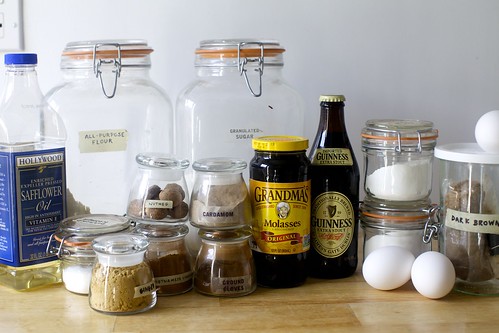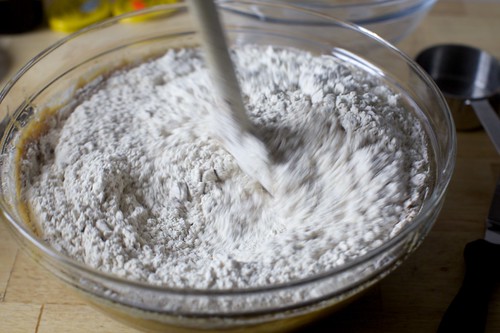
For the last seven Christmas Eves, I have made the gingerbread cake Claudia Fleming made famous during her time at Gramercy Tavern. The first year, I was so excited about it that I made it twice, first, for the holiday and then so I could tell you all about it because I think we all know that a Deb-fitted torture chamber would be me making some awesome cooking discovery and not being able to run to the internet to tell you about it immediately.


But every year after that, it’s given me a hard time. At first, I shrugged it off — a chunk stayed behind in the pan, I pasted it back on and showered the cake with an extra blizard of sugar “snow.” Two chunks stayed behind, we teased it for its lopsidedness while eating it with no-less-diminished vigor. But it didn’t get better from there. I assumed it was my greasing technique; maybe this cake was no match for my beloved Baker’s Joy? I doubled-down on the buttering and the flouring and was rewarded with the cake equivalent of a gap-toothed 6 year-old. I did the same but gave it 20 minutes to set in the freezer; it mocked my efforts. I switched to the Crisco my mom swears by for pan release; the hungry hungry bundt still ate a third of the cake. I questioned the half-life of factory-applied nonstick coating, but it was hard to ignore that the same coating was mighty effective at releasing other cakes. Finally, I pulled in the big guns, this mix of shortening, oil, and flour many more talented bakers than myself swear by; the situation was so bad that year, I had to make this cake at the last minute instead.





This is where the story arc demands a resolution. Here is where I’m supposed to say “But here’s what finally worked!” This is America! We like happy endings. Alas, as I’ve run out of solutions, I’ve instead changed vessels. Down with bumps and notches; down with shapes that do not allow for the ultimate in cake-release security, a layer of parchment paper. Up with celebratory layer cakes! Poured thin, sandwiched with whipped mascarpone cream, stacked high and a little messy and crowed with the festive-est berry tiara, we still get to eat our favorite gingerbread cake on Christmas Eve and the only chunk of gingerbread that isn’t going to make it to the table this year is that plated wedge up front. We’ll blame the elf.




One year ago: Deep Dark Gingerbread Waffles and Fairytale of New York
Two years ago: Linzer Torte and Breakfast Slab Pie
Three years ago: Cashew Butter Balls
Four years ago: Parsnip Latkes with Horseradish and Dill
Five years ago: Broiled Mussels and Spicy Gingerbread Cookies
Six years ago: Ridiculously Easy Butterscotch Sauce, Mushroom Marsala Pasta with Artichokes and How to Host Brunch (and Still Sleep In)
Seven years ago: Cranberry Vanilla Coffee Cake, Sausage-Stuffed Potato with a Green Salad, Seven-Layer Cookies, Grasshopper Brownies, Potato Pancakes, Even Better
Eight years ago: Austrian Raspberry Shortbread and Slice-and-Bake Cookie Palette
Nine years ago: Pecan Squares, Boozy Baked French Toast and Zucchini Latkes
And for the other side of the world:
Six Months Ago: Herbed Summer Pasta Bake
1.5 Years Ago: Frozen Coconut Limeade
2.5 Years Ago: Espresso Granita with Whipped Cream
3.5 Years Ago: Cold Rice Noodle with Peanut-Lime Chicken
4.5 Years Ago: Rich Homemade Ricottaand Linguine with Pea Pesto
Gingerbread Layer Cake with Whipped Mascarpone Cream and Sugared Cranberries
Adapted from Claudia Fleming (cake), Nancy Silverton (stabilized cream) and My Recipes (sugared cranberries)
This recipe makes three thin cake layers. As most of us have 2 cake pans, at best, you could also make it into two thicker cake layers, giving it a little more baking time. Or, you could do as I did, which is to hold the last bit of batter in a bowl until the first layer comes out and can be unmolded. It holds up just fine at room temperature for an hour. You’ll have up to 1 cup more whipped cream than you’ll need; you can make a little less or just keep the rest in a jar for another dessert. The cream stays stable due to the added mascarpone, although that was my preference and creme fraiche or sour cream are usually what’s recommended. (Read more about why here.) Finally, the sugared cranberries are something I auditioned at the last minute for the first time so I’m hardly an expert (but hope to be, in two or three bags); you’ll want to start them the night or day before. You’ll have way more than you’ll need; the rest make pretty gifts, festive treats or can be scattered on plates when serving.
Sugared Cranberries
1 cup (200 grams) plus 1/3 cup (65 grams) granulated sugar
1 cup water
1 cup (100 grams) fresh cranberries
Cake layers
1 cup (235 ml) oatmeal stout or Guinness Stout
1 cup (235 ml) dark molasses (ideally, not blackstrap)
1/2 teaspoon baking soda
3 large eggs
1 cup (190 grams) packed dark brown sugar
1 cup (200 grams) granulated sugar
3/4 cup (150 grams) vegetable or another neutral oil
2 cups (260 grams) all-purpose flour
1 1/2 teaspoons baking powder
2 tablespoons ground ginger
1 teaspoon ground cinnamon
1/4 teaspoon ground cloves
1/4 teaspoon freshly grated nutmeg
1/2 teaspoon kosher salt
Pinch of ground cardamom
Filling
2 cups (475 ml) heavy or whipping cream
6 tablespoons (45 grams) powdered sugar
1/2 cup (115 grams) mascarpone
Make sugared cranberries: Bring 1 cup granulated sugar and 1 cup water to a gentle simmer (not a full boil) on the stove, stirring until sugar has dissolved. Remove from heat and add cranberries. Pour mixture into a bowl and let syrupy cranberries chill in fridge overnight, or at least 8 hours. The next morning, drain cranberries (you can reserve syrup for soda or sweetening cocktails). Place remaining 1/3 cup sugar in a bowl and roll cranberries in it. Arrange them on a tray or plate and refrigerate for another 45 minutes to an hour, so that the sugar sets. (They’ll feel mostly dry to the touch.)
Make the cake layers: Heat oven to 350°F. Butter and flour, or use a nonstick spray to coat three 9-inch round cake pans (see note above re: if you have fewer) and line the bottom of each with a fitted round of parchment paper.
Bring stour and molasses to a boil in a large saucepan and remove from heat; whisk in baking soda carefully — it will foam up. Cool to room temperature.
In a large bowl, whisk together sugars and oil. Whisk in eggs, then whisk in cooled stout-molasses mixture. Place dry ingredients in a fine-mesh sieve or sifter and shake over bowl. Stir until just combined.
Divide batter into prepared cake pans; you’ll have about 2 1/4 cups or 565 grams of batter in each. Bake for 18 to 22 minutes, until a toothpick inserted into the center of the cake comes out batter-free. Cool in pan on rack for 5 minutes, then flip out onto cooling rack, carefully remove parchment paper (it’s sticky) and flip back right side-up, letting each layer cool completely. You can hasten this along outside (if it’s cold) or in the freezer.
Make whipped mascarpone cream: Beat heavy cream and powdered sugar in a large bowl with a whisk or electric beaters until soft peaks form. Beat in mascarpone, one spoonful at a time, just until it disappears into the cream.
Assemble cake: Place first cake layer on cake stand and level top with a serrated knife if it has domed. Spread with 1 cup whipped mascarpone. Repeat twice, then smooth sides. Decorate with sugared cranberries. Serve immediately, or keep refrigerated until needed.
Source: http://feedproxy.google.com/~r/smittenkitchen/~3/-2Ki6gU0siM/